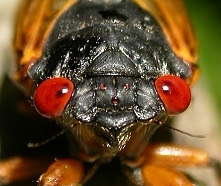We left about three weeks ago to travel to the US. On our return we found that the trees were alive with the sound of music. It’s not like they were playing jazz or anything but apparently we returned right into the middle of the most recent emergence of cicadas.
According to the National Taiwan University Insect Museum there are 65 different species of Cicadas in Taiwan. They range in size from two to five centimeters but some can get as large as 7 centimeters, that’s 2.75 inches for you Americans. That sounds like either a large bug or a small bird. Fortunately, they don’t feed on human or animal flesh, although, I have no idea how I would react if a three inch bug landed on my shoulder.
Cicadas feed by attaching their proboscis into a tree and sucking the sap from under the tree branches. They make a species specific sound to attract a mate. That’s the sound that we are hearing, day and night, night and day, light and dark, dark and light. It’s pretty noisy around here right now. In fact, there is one species of cicada that makes a sound at 120 decibels. That’s loud enough to cause hearing damage near your ear. So imagine that three-inch bug on your shoulder YELLING at you at 120 decibels. That might be a tad startling.
 |
Cicadas don’t make sounds like crickets. Crickets rub their legs together to produce their sound. Instead they click their exoskeleton to make sound. Built into their abdominal exoskeleton are some small flexible membranes between thick ribs called tymbals. As they contract their tymbalic muscles their bodies produce a click, when those muscles are relaxed it clicks again. Cicadas contract and relax the muscles very quickly to produce their sound.
As you might imagine cicadas have very few predators. Mostly birds and sometimes squirrels eat them. In my fertile imagination I can see a dogfight in the skies over Bade between a swallow and a three-inch cicada and I’m not at all sure who would end up the winner. They have two methods of protecting themselves from predators. The first is called the predator satiation method. In this method so many cicadas emerge at one time that the predators can’t eat them all. The predators eat so many that they become satiated and have no more interest in eating cicadas. Another name for this might be the, “What cicadas for dinner again?” method. The other method involves deception, as they emerge from the ground they shed their nymphal exoskeleton and leave it sitting around. Birds attack the discarded exoskeleton while the actual cicada is up in the tree eating and looking for a mate.
 |
| Platypleura Kaempferi: A species of Taiwanese Cicada |
Cicadas mate and then the female cuts slits in the twigs or small branches of the tree, she may lay several hundred eggs. When the eggs hatch the cicada nymphs fall to the ground and burrow. They will remain there until they are ready to emerge from the ground and begin the process all over again. A cicada nymph may remain in the ground for as long as 13 to 17 years, but more commonly, two to five years before emerging and going up into the tree to eat and find a mate.
Photo credit: NTU Insect Museum
Video Credit: iceanajenn

Chris Banducci is a pastor and missionary in Taiwan. He has, at other times of his life, been a white-water rafter, rock climber and adventurer. He left the corporate world of Solid Waste Recycling in 1996 and went into full-time ministry, where he pioneered a church in Riverside, California for the Potter’s House Christian Fellowship and is now engaged in the same endeavor in Taoyuan City, Taiwan. He writes on the culture, religion, tradition, and day-to-day life in Taiwan. Twenty-six years of living with Muscular Dystrophy may have weakened his muscles but not his spirit.








